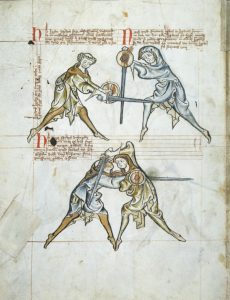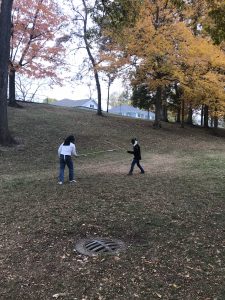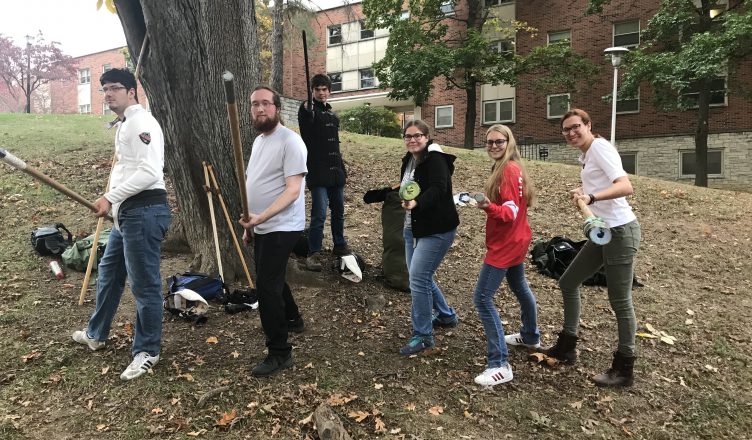I looked outside my window and tried to figure out what I was going to wear. It was a gray and chilly October day; not too windy, but it threatened rain, so I finally decided on a long sleeve shirt with a sweatshirt over it. Thinking that it ought to keep me warm enough, I headed outside to the grassy hill between Hayes and Stuy. Today, I was finally going to solve a mystery. I was going to see what exactly the Medieval Combat club was all about.
Ever since my freshman year I had seen them practicing on the hill by Hayes. Sometimes, when I needed a break from writing papers, I would lazily look out my window and be puzzled by what I saw. A small group of people would gather with large sticks and wooden swords. They would wear what looked like a thick layer of black clothing and fencing helmets. At the time I did not even know what the club’s official name was. I figured it was some sort of fencing group. However, the more I saw them, the more I wanted to learn what this club was about. So, after I started my new position as head student editor for the Trident, I decided this would be the perfect opportunity to meet them.

Studying medieval combat and western martial arts has been popular for decades. Though there is not a lot of information about combat techniques prior to the late medieval period, people with interest have poured over bits of manuscripts, instruction manuals, and artwork in order to piece together what western martial arts was like. There was a revival of practicing western martial arts and European combat in the 1890s, but it died out around the beginning of the 20th century. However, its popularity grew again, and it has been taught and practiced by organized groups regularly since the 1990s.
I made my way over to the spot on the hill, and found two large bags on the ground. These bags were filled with helmets and protective padding. There were also large wooden sticks and swords leaning up against a tree. Seeing where my gaze was, one of the club members proudly told me that an alumni had made the wooden swords and donated them to the club. I was rather impressed– the craftsmanship of the wood was precise. As the group gathered around, I apologized for being new. To be honest, I was a little embarrassed by the fact that I knew absolutely nothing about the club, purpose, or techniques. Here I was thinking I could jump into someone else’s club, without even being able to give the proper names of the equipment they carried! Luckily, the club members did not mind. They took time to teach me some medieval combat moves.

Let me start with this– medieval combat is not easy! But I did have fun and learned a lot about the club and its purpose. First, the president of the club, Jacob Bosko, told me about the weapons we used that day.
Weaponry design was very crucial to medieval soldiers because it had to pierce through thick plates of metal armour. Therefore, the impact of the weapon had to be centralized to a specific point to cause the most damage to an opponent. This was why spears were very popular. They could be used on horseback or foot, and typically were between the ranges of 9-12 feet long with a metal head at the end. For our purposes, we used spears sans the metal pointed tip that were only 7 feet long. We also used hand and a half swords, also known as bastard swords. These swords can be used with either one or both hands, which was considered a major asset at the time. They were designed to take heavier blows in order to break through the metal plating and could be over 40 inches long! Hand and a half swords were not typically used by civilians. Only soldiers and travelers used them because the swords could be rather awkward to carry on foot.
The technique involves both foot work and proper welding of the weapon. I tried to replicate the foot positions of the other club members. Being a dancer for most of my life, I would splay my feet into a turned-out position– and look similar to a duck! The hand and arm positions were more difficult for me. They would show me a swift movement that ended in a certain position of the hands and arms. I would mimic it in an awkward fashion, wondering if the other club members were about to give up hope! After several tries, I managed to get close to what they were looking for. I could really appreciate and understand how much strength it must have taken to wield these large weapons while wearing layers of heavy chainmail and metal armor.
Once they had taught me about the equipment and technique, it was my turn to try sparing. I put on the protective gear, which included a fencing helmet and black, fabric armor called a gambeson. Despite the fact that it was made out of fabric, it did well to protect against potential hits. However, this was nowhere near the amount of armor worn by actual medieval fighters. Prior to the 17th century, armor could weigh between 45 and 70lb, as armor had many components and layers to it. In many ways, armor is just like clothing. One had to put on the suit of armor, then the leg harnesses, torso armor, arm harnesses, helmets, and even decoration on top of all that! If you are curious to know what all the medieval fighters used, you must see this demonstration of dressing in late 14th century armour. Despite their heavy metal armor, medieval warriors could be quite agile. The weight of the armor was evenly distributed around the body. They still had the mobility needed for fighting. They could get on and off horses, scale ladders with only their hands. This makes sense– why would people invent armor that was nearly impossible to move in for battle? The surprising flexibility of armor can be seen in online videos that demonstrate fighting techniques used in armor.
For my sparring session, instead of using the hand and a half wooden swords, we used the longer spears. Before the practice, I was reminded of some moves I could use to bring my opponent’s spear to the ground. The club president warned me that the first couple of times doing these matches would be very exhausting. It sure was! After about 5 or 10 minutes, I was too tired to continue. Instead, I watched other club members sparr and practice. It was really interesting to watch them. It is good to see that some lessons from the past are still practiced and taught today.

The Medieval Combat club meets Mondays and Fridays from 4:30-5:30pm. You can find them either in the valley outside of Stuy or in Milligan Hub if the weather is bad!





